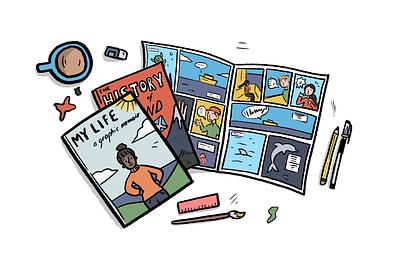Looking for all Articles by Georgia McLellan?
Five reasons to write a non-fiction comic
Former What's Your Story? participant, comic artist and full-time animation student Georgia McLellan shares some great reasons for trying out a non-fiction comic.

We all know that comics can tell fictional tales of superheroes and wizards, but they're also great for telling real life stories too! From historical books and memoirs, to graphic journalism and biographies – here are five reasons why you should consider writing a non-fiction comic…
You can play around with time
In comics, every panel stands on its own so the artist can have some fun by switching between different time periods. This is useful for non-fiction stories, which are often historical or explore some past event. Putting two drastically different time periods next to each other shows a contrast between events in the past and the present.
For example, you could have one panel showing WW2 soldiers on the battlefield, with the very next one being a peaceful scene of an old veteran reflecting on his youth. Within comics – the sky is the limit – you can even have multiple time frames unravelling at the same time!
Cartoon drawings help people to relate to a story
Some people argue that comics aren't 'proper' art – that they are just simple cartoons – but sometimes that's precisely the point. Research has shown that people project their own identities onto simple cartoon characters and therefore, they can connect to the story in a much more personal way.
The famous comic memoir writer, Marjane Satrapi, believes that the simpler the drawings, the better the story. So, don’t think you need to draw perfect, detailed scenes in order to connect to your reader.
They help you to learn
Multiple studies have found that comics are great at helping people to learn. The use of images and smaller doses of text are much clearer than word heavy textbooks and other learning materials. So, if you want your reader to learn something from your story, why not consider using the comics format?
They engage the senses
Unlike prose, comics bring together multiple senses on one page. Not only does the comic creator have the power of words, but they also have the power of visuals and symbols. They can represent the emotion behind dialogue.
For example, by making the speech bubble jagged and bold you can show anger, or if the text is faded and small you can show that someone is speaking quietly.
They're great for journalism
More and more creators are turning to comics as their medium for journalism, and with good reason. Comics are less intrusive than other journalistic forms such as photography or broadcasting. People feel more anonymous when they are being drawn rather than photographed, and comic journalists are more likely to gain access to people and places which would otherwise be closed off to them. Drawing a scene also requires the artist to really look – observing all the details of a place or mannerisms of a person. This could help give a more unique and truthful representation.
Everyone has a story to tell – whether it's a personal reflection, a piece of journalism or something to teach others. With more people interested in non-fiction storytelling, creators no longer need to be famous to write a memoir – it's all about the story. And what better way to tell your story than through a comic book!